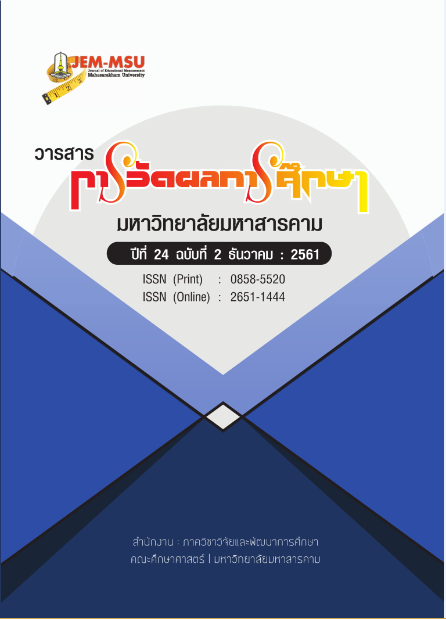Construction of a Life and Career Skill Test Basing on the Concept of 21st- Century Skills for Senior High School Students
Main Article Content
Abstract
The purposes of this research were: 1) to build a life and career skill test; 2) to find the quality of the life and career skill test; and 3) to build the norms of the life and career skill test basing on the concept of 21st- century for students in senior high school. The sample consisted of 618 senior high school students in the 2nd semester of the academic year 2016 in the schools under the Office of Secondary Education Service Area 25, obtained through multi-stage random sampling.
The results were as follows:
- The life and career skill test had 40 items. They were divided into aspects: 8 items on flexibility and adaptability; 8 items on initiative and self-direction; 8 items on social and cross-cultural skills ; 8 items on productivity and accountability; and 8 items on leadership and responsibility.
- The quality of the life and career skill test had the index of item-objective congruence (IOC) of 0.60 – 1.00, the discrimination of 0.319 – 0.748, the total reliability of 0.910. The construct validity obtained through second order confirmatory factor analysis revealed that the 5 aspects of the life and career skill test had the weight, ranked in descending order, as follows: leadership and responsibility, productivity and accountability, social and cross-cultural skill, flexibility and adaptability and initiative and self-direction, with the factor loadings of 0.993, 0.956, 0.936, 0.808 and 0.799, respectively, and with the index of consistency with empirical data. The chi-square value was 503.846; chi–square test of model fit was 1.105; the probability was 0.0601; the root mean square error of approximation (RMSEA) was 0.013; the comparative fit index (CFI) was 0.993; the Tucker-Lewis Index (TLI) was 0.988; the standardized root mean square residual (SRMR) was 0.050. All of these findings indicated that the model had validity.
- The norms in the form of normal T score showed the values from T24 to T72.
Article Details
The content and information contained in the published article in the Journal of Educational Measurement Mahasarakham University represent the opinions and responsibilities of the authors directly. The editorial board of the journal is not necessarily in agreement with or responsible for any of the content.
The articles, data, content, images, etc. that have been published in the Journal of Educational Measurement Mahasarakham University are copyrighted by the journal. If any individual or organization wishes to reproduce or perform any actions involving the entirety or any part of the content, they must obtain written permission from the Journal of Educational Measurement Mahasarakham University.
References
มหาวิทยาลัย.
เกียรติสุดา ศรีสุข. (2549). ระเบียบวิธีวิจัย. เชียงใหม่ : มหาวิทยาลัยเชียงใหม่.
ชนัดดา เทียนฤกษ์. (2557). การพัฒนาโมเดลการวัดทักษะชีวิตและอาชีพของนักเรียนชั้นมัธยมศึกษา
ตอนปลายในศตวรรษที่ 21. ปริญญานิพนธ์ปริญญาครุศาสตร์มหาบัณฑิต สาขาวิธีวิทยาการวิจัย
การศึกษา คณะครุศาสตร์ จุฬาลงกรณ์มหาวิทยาลัย.
ทรงศักดิ์ ภูสีอ่อน. (2558). การประยุกต์ใช้ SPSS วิเคราะห์ข้อมูลงานวิจัย. พิมพ์ครั้งที่ 7. มหาสารคาม :
ตักสิลาการพิมพ์.
ประเสริฐ ผลิตผลการพิมพ์. (2553). อย่าเรียนหนังสือคนเดียว. กรุงเทพฯ : สำนักพิมพ์ซีเอ๊ดบุ๊ค.
พัชรนันท์ มาอยู่วัง. (2552). การสร้างแบบวัดทักษะชีวิต สำหรับนักเรียนช่วงชั้นที่ 3 สังกัดสำนักงานเขต
พื้นที่การศึกษาเพชรบูรณ์ เขต 1. ปริญญานิพนธ์ปริญญาศึกษาศาสตร์มหาบัณฑิต สาขาวิจัยและ
ประเมินผลการศึกษา คณะศึกษาศาสตร์ มหาวิทยาลัยราชภัฏเพชรบูรณ์.
ไพศาล วรคำ. (2554). การวิจัยทางการศึกษา. พิมพ์ครั้งที่ 2. มหาสารคาม : ตักสิลาการพิมพ์.
วิจารณ์ พานิช. (2555). วิถีสร้างการเรียนรู้เพื่อศิษย์ในศตวรรษที่ 21. กรุงเทพฯ : มูลนิธิสดศรี-สฤษดิ์วงศ์.
สกล วรเจริญศรี. (2550). การศึกษาทักษะชีวิตและการสร้างโมเดลกลุ่มฝึกอบรมเพื่อพัฒนาทักษะชีวิตของ
นักเรียนวัยรุ่น. ปริญญานิพนธ์ปริญญาการศึกษาดุษฎีบัณฑิต สาขาวิชาจิตวิทยาการให้คำปรึกษา
คณะศึกษาศาสตร์ มหาวิทยาลัยศรีนครินทรวิโรฒ.
สมบัติ ท้ายเรือคำ. (2552). ระเบียบวิธีวิจัย. มหาสารคาม : มหาวิทยาลัยมหาสารคาม.
สมนึก ภุททิยธนี. (2558). การวัดผลการศึกษา. พิมพ์ครั้งที่ 10. กาฬสินธุ์ : ประสานการพิมพ์.
สุนทรพจน์ ดำรงพานิช. (2555). สถิติเพื่อการวิจัย. พิมพ์ครั้งที่ 3 . มหาสารคาม : มหาวิทยาลัยมหาสารคาม.
Ken Kay and Chris Dede. (2010). 21st Century Skill : Why They Matter, What They Are, and
How We Get They. Available from : http://www.learningthenow.com/blog/wp-
content. [accessed 22 March 2018].
Partnership for 21st Century Skills. (2014). Life and Career Skills.[Online]. Available from :
http://www.p21.org/about-us/p21-framework/266. [accessed 10 November 2015].


